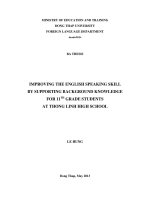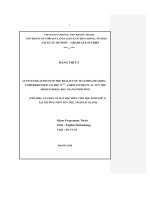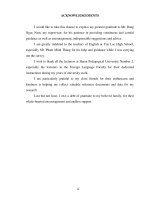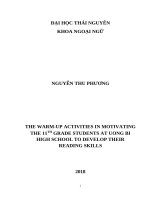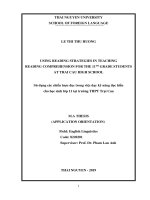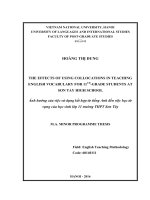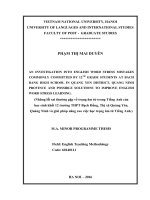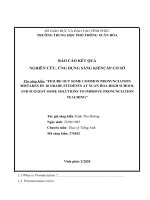A study of common errors in pronouncing a group of fricative sounds experienced by 11th grade students in yen lac high school
Bạn đang xem bản rút gọn của tài liệu. Xem và tải ngay bản đầy đủ của tài liệu tại đây (968.11 KB, 49 trang )
HANOI PEDAGOGICAL UNIVERSITY No.2
FACULTY OF FOREIGN LANGUAGES
----------
HA THI KIM ANH
A STUDY OF COMMON ERRORS IN PRONOUNCING
A GROUP OF FRICATIVE SOUNDS EXPERIENCED
BY 11 th GRADE STUDENTS IN YEN LAC HIGH SCHOOL
(SUBMITTED IN PARTIAL FULFILLMENT OF THE REQUIREMENTS OF
THE DEGREE OF BACHELOR OF ARTS OF ENGLISH)
B.A THESIS IN ENGLISH
SUPERVISOR: NGUYEN THI MINH PHUONG M.A
DR. WILLIAM H. SALAZAR
Ha Noi, 2018
i
ACKNOWLEDGEMENTS
I would like to express my deepest gratitude to Mrs. Nguyen Thi Minh
Phuong,
my
research
supervisor,
for
her
patient
guidance, enthusiastic
encouragement and useful critiques of this research work. I am truly grateful to her
ideas, comments and instructions as well as constant support. Without these, the
thesis could not have been completed.
I would also like to extend my thanks to Dr. William H. Salazar my
researcher supervisor for his great contribution to my study. He helped me
whenever I met a trouble or had a question about my research or writing. He
consistently allowed this paper to be my own work, but drove me in the right the
direction whenever he thought I needed it. Without his invaluable contribution and
input, the survey could not have been successfully conducted.
I would also like to thank many beloved students in Yen Lac High School
who took part in my research inquires enthusiastically and completely. If I had not
received their support, I would have not been completed my research on time.
My special thanks are expressed to my friends in Hanoi Pedagogical
University No.2 for their great help and comments. They inspired and encouraged
me a lot when I have trouble during my research process.
Finally, I wish to thank my parents for their support and encouragement
throughout my study.
i
ABSTRACT
This research was conducted to explore the fricative sounds which students
in Yen Lac High School frequently mispronounce. Then researcher suggested some
techniques and solutions to improve their pronunciation skills in terms of fricative
sounds. The scope of the study was done with the participant from two classes
included forty 11 th grade students. Questionnaire, recorded test and classroom
observation were employed as the data collecting instruments. The results of the
research revealed the problematic sounds and the ways that Yen Lac High School
students made mistakes when pronouncing fricative sounds. The study, based on the
findings, would help students and teachers recognize the limitation of learners in
pronouncing English. Hence, teachers and students could find appropriate ways to
teach and correct English pronunciation.
ii
STATEMENT OF AUTHORSHIP
Tittle:
A STUDY OF COMMON ERRORS IN PRONOUNCING A GROUP OF
FRICATIVE SOUNDS EXPERIENCED BY 11 th GRADE STUDENTS IN
YEN LAC HIGH SCHOOL
I certify that I am the sole author of this bachelor of art thesis and this study
has not been copied by me from any other person‘s work than sources listed in the
bibliography as references. I further declare that this work is written by my best
under the instruction from my supervisor.
Date submit: May, 9th 2018.
Student
Ha Thi Kim Anh
Supervisor 1
Nguyen Thi Minh Phuong M.A
iii
Supervisor 2
Dr. William H. Salazar
TABLE OF CONTENTS
ABSTRACT............................................................................................................................. ii
STATEMENT OF AUTHORSHIP ..................................................................................... iii
TABLE OF CONTENTS ....................................................................................................... iv
LIST OF TABLES .................................................................................................................. vi
PART I: INTRODUCTION
1. Rationale ...............................................................................................................................1
2. Aims of the study .................................................................................................................1
3. Research question ................................................................................................................2
4. Scope of the study ................................................................................................................2
5. Significance of the study .....................................................................................................2
6. Overview of the study .........................................................................................................2
PART II. DEVELOPMENT
CHAPTER 1: LITERATURE REVIEW
1.1. Pronunciation ....................................................................................................................4
1.1.1. Definitions of pronunciation ........................................................................................4
1.1.2. The significance of pronunciation ...............................................................................4
1.1.3. Aspects of pronunciation ..............................................................................................5
1.1.3.1. Phonemes ....................................................................................................................5
1.1.3.1.1. Vowels ......................................................................................................................5
1.1.3.1.2. Consonants ...............................................................................................................6
1.1.3.2. Stress ......................................................................................................................... 11
1.1.3.2.1. Word stress ........................................................................................................... 12
1.2. Fricative sounds ............................................................................................................. 12
1.2.1. Definitions of fricative sounds.................................................................................. 12
1.2.2. Classification of fricative sounds ............................................................................. 13
1.2.3. Descriptions of “/θ/, /ð/, /s/, /z/, /ʃ/, /ʒ/, /h/, /f/, /v/” sounds .................................. 14
1.3. Pronunciation errors ...................................................................................................... 16
iv
CHAPTER 2: METHODOLOG Y
2.1. Participants ..................................................................................................................... 19
2.2. Data collection instruments .......................................................................................... 19
2.2.1. Questionnaire .............................................................................................................. 19
2.2.1.1. Rationale of questionnaire...................................................................................... 19
2.2.1.2. Procedure of questionnaire..................................................................................... 19
2.2.2. Recorded Test ............................................................................................................. 20
2.2.2.1. Rationale of recorded test....................................................................................... 20
2.2.2.2. Procedure of recorded test...................................................................................... 20
2.2.3. Classroom observation............................................................................................... 20
2.2.3.1. Rationale of the classroom observation................................................................ 20
2.2.3.2. Procedure of the classroom observation............................................................... 21
CHAPTER 3: FINDINGS AND DISCUSSION
3.1. Findings........................................................................................................................... 23
3.1.1. Results of the questionnaire ...................................................................................... 23
3.1.2. Results of the recorded test and classroom observation ........................................ 25
3.2. Discussion ....................................................................................................................... 29
CHAPTER 4: PEDAGOGICAL IMPLICATION
4.1. Suggested solutions ....................................................................................................... 31
4.1.1. Suggested solutions for teachers............................................................................... 31
4.1.2. Suggested solutions for learners ............................................................................... 31
PART III: CONCLUSION
1. Summary of the study....................................................................................................... 34
2. Limitations of the study ................................................................................................... 34
3. Suggestions for further studies ........................................................................................ 35
REFERENCES ...................................................................................................................... 36
APPENDICES ....................................................................................................................... 38
v
LIST OF TABLES
Table 1: Vowels in English .....................................................................................................5
Table 2: English vowel chart ..................................................................................................6
Table 3: Consonants in English ..............................................................................................7
Table 4: Classification of NAE Consonant Phonemes ........................................................7
Table 5: Place of articulation of plosive phonemes .............................................................9
Table 6: Place of articulation ............................................................................................... 13
Figure 1: Students' attitudes toward the importance of pronunciation skills ................. 23
Figure 2: Students’ self-evaluation of pronunciation ....................................................... 24
Figure 3: Students' difficulties in pronouncing English ................................................... 25
Figure 4: Mispronounced fricative sounds......................................................................... 25
Table 7: Errors that students made when pronouncing some fricative sounds ............. 26
Table 8: Errors with /f/ sound .............................................................................................. 27
Table 9: Errors with /θ/ sound ............................................................................................. 27
Table 10: Errors with /ð/ sound ........................................................................................... 28
Table 11: Errors with /s/ sound............................................................................................ 28
Table 12: Errors with /z/ sound ........................................................................................... 28
Table 13: Errors with /h/ sound ........................................................................................... 28
Table 14: Errors with /v/ sound ........................................................................................... 28
Table 15: Errors with /ʃ/ sound ............................................................................................ 29
Table 16: Errors with /ʒ/ sound ........................................................................................... 29
vi
PART I: INTRODUCTION
1. Rationale
As a developing country, Vietnam currently has an urgent need to use the
international language English, to promote economic investment, especially after
becoming a member of World Trade Organization (Nguyen Thi Thu Thao, 2007).
English has been a compulsory subject in school for many years, from primary school
to higher education. Nowadays, people are aware of the significant role of English and
take it as a mean to develop other career like Math, Physics, Chemistry, Biology.
Pronunciation is the most important skill in spoken language; however, many of
English language learners find it difficult to master English pronunciation (Gilakjiani,
2011). Hinofotis, 1981 stated “Problems in pronunciation weaken their communicative
competence”. Moreover, though many of students have learnt English as Second
Language they still lack sufficient competence in pronunciation skills (Charity and
Mallision, 2011). That is because of many factors. The first reason is the impact of
mother tongue on English. Like some other languages, Vietnamese has phonotactic
features that keep native learners from pronouncing English like native speaker
(Nguyen Thi Thu Thao, 2007). The second reason is that high school students likely to
focus on grammar and vocabulary instead of speaking skills. There are extremely
limited opportunities for learning listening and speaking of English in Vietnam. In
fact, the pronunciation of English challenges Vietnamese learners; however students
were not trained on how to pronounce English phonetics accurately and how to correct
their mispronunciations at the beginning stage of learning English. Kelly (2004),
pointed out two problems concerning teaching pronunciation: “First, it tends to be
neglected. And secondly when it is not neglected, it tends to be reactive to a particular
problem that has arisen in the classroom rather than being strategically planned”.
Therefore, this paper will investigate and find out the common errors in the
pronunciation of fricative sounds mostly faced by students in high school and give
some suggestions for this phenomenon.
2. Aims of the study
This study was conducted to achieve the main following aims:
1. To investigate fricative sounds (/θ/, /s/, /f/, /z/, /ʃ/, /ð/, /ʒ/, /h/, /v/) which students
frequently make mistakes in pronouncing.
2. To investigate the factors that cause the poor pronunciation of Yen Lac High
1
School students.
3. To investigate the most effective ways to help learners minimize the difficulties in
pronunciation.
3. Research question
To fulfill these purposes mentioned above, this paper seeks answers to the
following question:
1. What are some common mistakes in pronouncing a group of fricative sounds
experienced by 11 th grade students in Yen Lac High School?
4. Scope of the study
The research was conducted to investigate the common errors in pronouncing a
group of fricative sounds “/θ/, /ð/, /s/, /z/, /ʃ/, /ʒ/, /h/, /f/, /v/”. The research was carried
out on a group of forty 11 th grade students from two classes in Yen Lac High School,
they accounts for ten percent of the total population.
5. Significance of the study
After the research, it is hoped that the results will be helpful to provide:
1. Input for English learners to minimize their difficulties in pronouncing fricative
sounds which they mostly pronounce wrongly. Then they can self-correct their
incorrect pronunciation.
2. Input for English teachers some methods to help students pronounce better.
6. Overview of the study
The research work has three main parts: Introduction, Development and
Conclusion.
Part I: The “Introduction” consists of the rationale, aims of the study, research
question, scope of the study, significance of the study and overview of the study.
Part II: The “Development” consists of four main chapters:
Chapter 1: Literature review. This chapter reviews previous studies of some
well-known researchers to give the reader a theoretical background of English
pronunciation and fricative sounds.
Chapter 2: Methodology. This chapter describes how to do the study by
presenting the techniques and procedures of the research.
Chapter 3: Findings and discussion. This chapter presents the result of research
and the analysis of the data.
Chapter 4: Pedagogical implication. This chapter gives some suggested
solutions for learners to enhance their pronunciation.
2
Part III: In the “Conclusion” part the researcher gives a brief summary of the study,
the limitations of the study and suggestions for further studies.
3
PART II. DEVELOPMENT
CHAPTER 1: LITERATURE REVIEW
1.1. Pronunciation
1.1.1. Definitions of pronunciation
Gilakjani (2016) claimed that pronunciation refers to the making of English
sounds. We learnt pronunciation by repeat the sounds over and over and correcting
them when pronounced incorrectly. When beginners start learning pronunciation they
have to make new habits and overcome the trouble coming from the mother tongue.
According to Yates (2009), pronunciation is the production of sounds that is used for
making meaning. Similarly, Paulston & Burder (1976) stated that pronunciation is the
production of a sound system which does not interfere with communication from the
speakers’ and the listeners’ viewpoints as well. To add to the understanding of
pronunciation Otlowski (1998) said that pronunciation is the way of saying a word in
an accepted manner. In addition, Richard and Schmidt (2002) defined pronunciation as
the way of producing certain sounds.
1.1.2. The significance of pronunciation
Otlowski (1998) claimed that the way we speak reveals something about
ourselves to the people around us. Learners with good pronunciation in English are
more likely to be understood even if they make errors in other aspects like grammar.
No matter how perfect a learner’s grammar is, and no matter how extensive and large
his vocabulary is, if he pronounces poorly then this immediately makes a negative
impression of his overall language level (Brown, 2009). Surveys of student needs
consistently show that they need for pronunciation lessons in class (Willing 1989).
Thus a pronunciation class is essential.
Gilakjani (2011) in The significance of pronunciation in English Language
Teaching claimed that pronunciation should be considered as more than correct
production of single sounds or detached words. Instead, it should have been seen as an
essential element of communication that should be involved in classroom activities.
We should view English pronunciation instruction as the same role as the other aspects
and skills of the English language, such as vocabulary, grammar, reading, writing
since it is a crucial part of communication. In conclusion, pronunciation must be
incorporated in the materials, classroom activities and testing tools; and the teachers
4
should take English pronunciation teaching seriously and bring it into school lessons.
1.1.3. Aspects of pronunciation
1.1.3.1. Phonemes
1.1.3.1.1. Vowels
Vowels are sounds in which the air stream moves up from the lungs and
through the vocal tract very smoothly; there’s nothing preventing it. Vowels are the
“heart” of syllable (Mara Yoshida, 1996). There are 15 vowels in English. They are
listed as follows:
Table 1: Vowels in English
According to Peter Roach (2009) English vowels are divided into 4 categories
by four questions:
- How high is the tongue? According to this criterion there are:
▪ High vowels if they are made with either the front or the back of the tongue is high in
the mouth. It is raised above its rest position, such as in /i:/, /u:/
▪ Low vowels if they are made with the tongue below its rest position, such as in /ʌ/
▪ Mid vowels if they are made with the tongue between its position, not too high and
not too low in the mouth such as in /e/
- What part of the tongue is raised? According to this question we have:
▪ Front vowels: are the vowels produced when the front of the tongue is raised to the
highest point in the mouth, such as in /i:/
▪ Back vowels: are the vowels produced when the back of the tongue is raised to the
highest point in the mouth, such as in /u:/
▪ Central vowels: are the vowels produced when the middle of the tongue is raised to
the highest point in the mouth, such as in /ə/, /ʌ/
- How long or short is the vowel? According to this question we have
▪ Long vowels: are the vowels pronounced longer and stronger than the short one, such
5
as in /i:/, /u:/.
▪ Short vowels: are the vowels pronounced shorter and weaker than the long one, such
as in /i/, /u/.
- How is the shape of lips? Although the lips can have many different shapes and
positions, at this stage the researcher will consider only three possibilities. These are:
▪ Rounded vowels: are produced when the corners of the lips are brought towards each
other and the lips pushed forwards, such as in /u/
▪ Spread vowels: are produced when the corners of the lips moved away from each
other, as for a smile, such as in /i/
▪ Neutral vowel: are produced when the lips are not noticeably rounded or spread. The
noise most English people make when they are hesitating, such as in /ə/
All of these categories can be presented in the diagram below:
Table 2: English vowel chart
1.1.3.1.2. Consonants
In the book Understanding of teaching the Pronunciation of English (Maroa
Yoshia) she found the following: “Consonants are sounds in which the air stream
meets some obstacles in the mouth on its way up from the lungs... Most consonants are
not as smooth-sounding as vowels; they pop, hiss, snap, or hum.” There are alternate
symbols for a few of these sounds, but overall, in American English and British
English the consonant symbols are very consistent across different versions of the
6
phonemic alphabet. There are 24 consonants in English. They are listed as follows:
Table 3: Consonants in English
According to Roach (1991) in English Phonetic and Phonology consonants
are divided based on place of articulation and manner of articulation.
The place of articulation is the location of the obstruction of air stream in the
articulation of the consonants. Here is the classification of North American English
consonant phonemes.
Table 4: Classification of NAE Consonant Phonemes
7
According to the place of articulation: It describes the point at which the
articulation actually touches or it is at its closest. Describing the consonant sounds this
way gives more information about what the various articulators actually do.
Bilabials: are the sounds made with the two lips pressing together or coming
together / p, b, m, w/.
Labio-dentals: are the sounds which are produced with the lower lip touching
the upper front teeth /f, v/.
Dentals: are the sounds which are produced when the tip tongue touching the
inside of the lower front teeth and the blade touching the inside of the upper teeth, for
instance: /θ/ and /ð/.
Alveolars: are the sounds which are produced when the air escape through a
narrow passage along the center of the tongue, for instance: /t/ and /d/.
Palato alveolars: are the sounds produced with the tongue tip or blade coming
close to the area between the back of the alveolar ridge and the front of the hard palate,
such as /ʒ/ and /ʃ/.
Palatals: are the sounds produced with the back to of tongue touching the soft
palate, such as /k/ and /g/.
Glottals: are the sounds produced without the active use of the tongue and
other part of the mouth /h/.
According to the manner of articulation: is the way where the airstreams are
obstructed and so altered the production of speech sound. It describe the time of
obstruction caused by the narrowing or closure of articulators.
Plosive (stops): are the sounds produced when there is a complete closure of
articulators involved so that air streams cannot escape through the mouth. They are
also sometimes called stop sounds. There are two types of plosives: Oral plosives and
nasal plosives.
Fricatives: are the sounds with the characteristics that when they are
produced, air escapes through a small passage and makes a hissing sound. Fricatives
are continuant consonants, which means that you can continue making them without
interruption as long as you have enough air in your lungs.
Affricates: they appear when a complete closure is made somewhere in the
mouth, and the soft palate is raised. Air pressure increases behind the closure, and then
is released more slowly than in plosives.
Laterals: are the sounds made with an obstruction of the airstream at a point
8
along the center of the oral tract with incomplete closure between one or both sides of
the tongue and the roof of the tongue.
Nasals: are the sounds made when a complete closure is made somewhere in
the mouth, the soft palate is lowered, and air escapes through the nasal cavity.
Approximants: are the sounds produced when two articulators come close
together but without the vocal tract being narrowed to such an extent that a friction
noise is produced.
According to the voicing: We use the following terms: fortis and lenis. In
some certain situations in the linguistic level, the voice opposition may be lost then the
energy of articulation becomes an important factor. For instance, a voiceless/ voiced
sounds such as p, t, k and b, d, g are distinguished not only by the presence or absence
of voice but also by how strong we breathe involved in the articulation. In English,
there are some consonants which are tend to be articulated with pretty weak power,
while there are some which are always voiceless are relatively strong. Thus, it may be
easy to define p, t, k as fortis (strong) and b, d, g as lenis (weak). Fortis consonants
normally shorten the preceding vowels, while lenis consonants often lengthen the
preceding vowels (Tam, p15-16). Actually, it is a little difficult to remember the term
fortis and lenis; however, we will follow the practice of many books and use these
terms. According to Roach (1991), the plosive phonemes of English can be presented
in the form of table as shown below:
Table 5: Place of articulation of plosive phonemes
Place of articulation
Bilabial
alveolar
Fortis
p
velar
t
k
(“voiceless”)
Lenis
b
d
g
(“voiced”)
The above table can be designed for all the other different consonants. Each
group of consonant such as plosive like p, t and k fricatives like s and z and nasals like
m and n obstructs the airflow in a different way, and they are categorized as different
manners of articulation.
According to the classification of consonants in English table we can easily
see some fricative pairs of sounds.
9
Both /f/ and /v/ are labiodental sound which are articulated with lower lips and upper
lips. The fricative noise is never very strong and is scarcely audible in the case of /v/.
/θ/ and /ð/ both of them are dental fricatives. The air escapes through the gaps between
the tongue and the teeth.
/s/ and /z/ both of them are alveolar fricatives. The air escapes through a narrow
passage along the center of the tongue and the sound produced is comparatively
intense.
10
/ʃ/ and /ʒ/ both are palate-alveolar, which can be understand that their place of
articulation is partly palate and alveolar.
1.1.3.2. Stress
A stress syllable is made when we pushing more air out of the lungs. It may
also have an increase in laryngeal activity. Stress can always be define in term of
something a speaker does (Ladefoged, 1975).
Roach (1991) said that stress, as a sound phenomenon, can be studied from two
aspects: production and perception. The production of stress syllables is said to signify
a greater energy than the production of unstressed syllables. From the perceptive point
of view, stressed syllables are outstanding. Prominence includes of different factors
such as loudness, length, pitch and quality.
Roach (2009) stated that many experiments have been conducted on the
perception of stress, and it is clear that many different sound characteristics are
important in making a syllables recognizably. There are four main different reasons
which make stressed syllable important.
The time we articulate a syllable plays an important part in prominence. If
one of the syllable in our “nonsense word” is made longer than the others, that
syllables are likely to be heard as stressed.
Every voiced syllable is said on some pitches; in this term it refers to the
frequency of vibration if the vocal fold and to the musical notion of low and highpitched notes.
If one syllable in our “nonsense word” is said with a pitch that is
remarkably different from the others, this is likely to produce the effect of prominence.
If a syllable contains a vowel which is not similar with its neighboring
vowel, it will be prominent.
Actually, loudness is an element of prominence so if one syllable is made
louder than the others, it will be heard as stressed.
Functions of stress
Stress can be used to express the speakers’ attitude and emotion.
For instance: A said: “Chocolate and ice-cream, which one do you choose?”
B said “Chocolate ‘and ice-cream”
In the B’s answer, he stresses the word “and” to emphasize that he wants both of
chocolate and ice- cream.
Stress also can indicate the syntactic relationships between words or parts
of words.
11
For example:
The word “present”, if we put the stress on the first syllable we have a noun
“present” which means “gift”. If we put the stress on the second syllable we have a
verb “present” which means “give a speech, or explanation”
Stress has a syntactic function in distinguishing between compound nouns.
For example: ‘Whitehouse (Official work place and residence of president), White
‘house (A house painted in white).
1.1.3.2.1. Word stress
According to Ann (2013) claimed that stress is one of the most magical
speech tools used by English speakers to convey meaning. English speakers emphasize
what they think is important by using stress. Moreover, every English word which has
more than one syllable or word part has a defined stress pattern. Therefore, you can
know which syllable is stressed by looking up. The importance of English stress is the
same to English sounds.
The English stress system is divided into some categories stressed and
unstressed syllables, stressed and unstressed words. Stressed syllable are longer and
more emphasized than unstressed syllable. They also have some pitches change or
movement of the voice up or down. Normally, stress in a word is divided into three
groups: a primary stress, characterized by prominence and by a rise –fall tone; a
secondary stress, weaker than the primary stress but stronger than that of the
unstressed syllables; and unstressed syllables, defined by no prominence, becoming
then the background against the prominent stressed syllables appear. Unstressed
syllables normally have the short closed vowels and the schwa.
1.2. Fricative sounds
1.2.1. Definitions of fricative sounds.
According to Roach (1991) fricatives are consonants with the characteristic that
when they are produced, air escapes through a small passage and makes a hissing
sounds, sometimes called “friction”. In fact, every language has fricatives, including
some sounds like “s’’. Fricatives are continuant consonants, which means you can
keep saying these consonants continually without interruption as long as you have
enough air in your lung. (There are some consonants which are not continuant like
plosives: p, b, f, t) .In the consonant articulation, two organs are brought and held close
together or the escaping airstreams to produce strong friction. Hence, like plosives,
fricatives are characterized by a noise component. This friction may or may not be
12
accompanied by voice.
English has a complex system of fricative phonemes. They can be seen in the
table below:
Table 6: Place of articulation
Labiodental
Dental
Alveolar
Palate-
Glottal
alveolar
Fortis
f
θ
s
ʃ
v
ð
z
ʒ
h
(Voiceless)
Lenis
(Voiced)
1.2.2. Classification of fricative sounds
According to classification of English consonant phonemes we have some types
of fricatives.
Labio-dental fricatives /f, v/ (example: fan, van, fish, halve)
When producing these sound we raise the soft palate and close the nasal
resonator. In order to produce friction form the escaping air, the inner surface of the
lower lip makes a light contact with the edge of the upper teeth. For /f/, the friction is
voiceless, whereas they may become vocal cord vibration accompanying /v/. In short,
/f/ and /v/ are labiodentals, that is, the lower lip is in contact with the upper teeth. The
fricative noise is never strong and is scarcely audible in the case of /v/.
Dental fricatives /θ, ð/ (example: this, that, thank, think)
When producing these sounds, we raise the soft palate in order to force all the
breath to go through the mouth, the tip of the tongue contact with the inner surface of
upper teeth. These sounds have sometimes been described as if the tongue was actually
placed between the teeth and it is common for teacher to teach the students to do this.
However, the tongue normally placed inside the teeth. The tip of the tongue touches
the inside of the lower front teeth and the blade touches the inside of the upper teeth.
The air escapes through the gaps between the tongue and the teeth.
Alveolar fricatives / s, z/ (example: see, star, increase, rice, zip, zoo)
These sounds are produced when we raise the soft palate and close the nasal
resonator then the tip and blade of the tongue make a high contact with the upper
alveolar ridge. The friction between the tongue and the alveolar ridge is created
because the air stream escapes through the narrow groove in the center of the tongue.
In other words, alveolar fricatives share the same articulation as t and d. The air
13
escapes through a narrow passage along the center of the tongue and the sound
produced is comparatively intense.
Palato – alveolar fricatives /ʃ, ʒ/ (example: shoes, measure, sure)
As we can see from the name of this fricatives, their place of articulation is
palatal, partly alveolar. The tongue is in contact with an area slightly further back than
that for /s/ and /z/. When speakers make /s/ then /ʃ/, they should be able to feel their
tongue move backward, the air then escapes through a passage along the center of the
tongue as in /ʒ/ and /z/. Most BBC speakers have round lips for /ʃ/ and /ʒ/ and this is
an important difference between these consonants and /s/ and /z/. /ʃ/ is a common and
widely-distributed phoneme, but /ʒ/ is not. Very few English words begin with /ʒ/
(most of these words come from French) and not many end with this consonant. Only
medially, in words such as “measure”, “usual”.
Glottal fricatives /h/ (horse, house, ahead)
The place of articulation of this consonant is glottal. This means that the
narrowing which produces the friction noise is between the vocal folds. If you breathe
out silently, then produce h, you are moving you vocal folds from wide apart to close
together. In speaking English, there are many different cases happen in different
contexts. For example, the word ‘hot’, the /h/ followed by an /ɒ/ vowel. The tongue
jaw and lip position will be produced together in order to create /ɒ/ quality of glottal
fricative. Likewise, the h sound will always have the quality of the next vowels.
Phonologically, /h/ is a consonant. It is usually identified before vowels. As well as
being found in initial position it is found medially in words such as: ‘ahead’ and
‘greenhouse’. It is obvious that when /h/ occurs between voiced sounds, it is
pronounced with voicing-not the normal voicing of vowel but a weak, slightly fricative
sound called breathy voice.
1.2.3. Descriptions of “/θ/, /ð/, /s/, /z/, /ʃ/, /ʒ/, /h/, /f/, /v/” sounds
/θ/ sound is a voiceless interdental fricative sound
Possible positioning
▪ Initial position as in thin, thief, thought
▪ Medial position as in athlete
▪ Final position as in health
When you pronounce voiceless sounds you cannot feel any vibration of the throat. You
can feel air being forced between the tip of your tongue and your upper front teeth.
Any sound that is created by creating friction by forcing air through a narrow channel
14
is known as a fricative.
/ð/ sound is a voiced sound
Possible positioning
▪ Initial position as in these, there, that
▪ Medial position as in weather, leather, father
▪ Final position as in with
If you pronounce /ð/ sound, you would feel the vibration in your throat. You can also
feel your tongue tip acting against your upper front teeth.
/s/ sound
Possible positioning
▪ Initial position as in sound, sit, sea
▪ Medial position as in essay, escape
▪ Final position as in pass, increase, difference
This sound is totally voiceless. You will be able to feel air being forced between the
tongue and alveolar ridge.
/z/ sound
Possible positioning
▪ Initial position as in zoo, zebra
▪ Medial position as in exit, represent
▪ Final position as in bronze, was
This sound is very clearly a voiced sound. As the /s/ sound you can feel air being
forced through the tongue and the alveolar ridge, meaning that it is a fricative being
articulated at the alveolar.
/ʃ/ sound
Possible positioning
▪ Initial position as in shoe, sure, shooting
▪ Medial position as in mission, fashion
▪ Final position as in accomplish
This sound is a voiceless sound; however, it is quite difficult to differentiate where in
the mouth it is articulated. It seems to be between the alveolar ridge and the hard
palate and so some people call it a palato – alveolar.
/ʒ/ sound
Possible position
▪ Initial position genre
15
▪ Medial position as in usual, leisure
▪ Final position as in rouge, beige
When pronounce this sound, you can easily feel the vibration in your throat
when you place your finger on. The position of the tongue is around where the hard
palate and the alveolar ridge meet, making it a palato – alveolar consonant. You should
also be able to feel the air being forced between the tongue and palato – alveolar ridge,
making it a fricative.
/v/ sound
Possible positioning
▪ Initial position as in venture, vanish, visit
▪ Medial position as in never
▪ Final position as in of, behave
This is a voice sound, if you put your fingers on your throat. Because /v/ is a labio –
dental, fricative, you can be able to feel the air being squeezed past your lower lip and
upper front teeth.
/f/ sound
Possible positioning
▪ Initial position as in fish, find, friend
▪ Medial position as in effort
▪ Final position as in leaf, laugh
This sound is voiceless. You can feel that your top teeth are touching your lower lip,
and so is a labio-dental sound. Finally, you should be able to feel the friction of the air
as it forces its way between the lips and teeth, and this is what is called a fricative .
/h/ sound
Possible positioning
▪ Initial position as in heart, heal, help
▪ Medial position as in ahead, adhere, behave
▪ Final position does not appear
This sound is the voiceless equivalent of /g/. The place of articulation should be felt as
being the soft palate at the back of your mouth.
1.3. Pronunciation errors
According to Duong Thi Nu (2008) Vietnamese learners of English often
confuse /ʃ/ /ʒ/ /ʧ/ /ʤ/ with other sounds. It is classified into four pairs:
1. /ʃ/ - /s/
16
The confusion of this sound pair can be explained that the speakers cannot
figure out the difference between the two sounds. Another reason for this confusion is
the negative impact of the mother tongue. Vietnamese learners are too much
influenced by the way they pronounce /s/ in Vietnamese. Consequently, though they
are able to aware of the difference between too sounds, they do not pronounce them
differently. For instance: /ʃiːt/ (sheet) is frequently pronounced as /siːt/ (seat)
2. /ʒ/ - /z/
Vietnamese often fail to pronounce /ʒ/ as a fricative sound. They often turn / ʒ/
into /z/ sound. These two sounds are both voiced fricatives and alveolar. When
learners commit errors in /ʒ/ it means they fail to make /ʒ/ palatal. In fact, while /z/ is
alveolar sound which is produced when the tongue contacts with the inside of the
lower front teeth, the blade touches the inside of the upper teeth and the air escapes
through a small passage along the center of the tongue. /ʒ/ is alveolar-palatal, the place
of articulation is partially palatal and partially alveolar. This sound is produced when
the tongue is in contact with an area further back than that of /z/ and the air escapes
through a passage along the center of the tongue as in /z/
3. /ʤ /- /z/ or /s/
When learners commit errors, they fail to make /ʤ / palatal and voiced. In
Vietnamese consonant system, there are no affricatives so many Vietnamese who learn
English have difficulties in pronouncing /ʤ /.
4. /ʧ/ - Vietnamese/ć/.
When learners make this mistake, they make /ʧ/ plosive stop instead making
alveolar and affricate. Like /ʤ/, /ʧ/ is produced by beginning with a plosive stop sound
and finishing with a fricative sound. Vietnamese when learning English often
mispronounce /ʧ/ like Vietnamese / ć/ which is a voiceless palatal stop and which is
produced with the blade of tongue is in contact with the hard palate.
According to Ha Cam Tam (2005) pronunciation was divided into three main
groups:
The first type is “sound omission”. When l, ʤ, r, s, i, ei, k appears in the middle
and z, s, t, v, ks, ʤ appears in the final of a word learners are likely to omit them.
The second type is “sound confusion”. The most frequent confusion are t = ʧ,
tr = ʧ, ð = z/d, ʃ = s, ʤ = /j/d/s/t/z/ʧ/, s = /ʃ/ʒ/, p = b; ʧ = s, θ= /s/t/; r = z. There are
learners who mispronounced /t/ and changed it into /ʧ/ instead. This confusion may be
due to the misperception of articulation of this sounds. The mispronunciation of /s/ to
17
/ʃ/, / ʒ/ or /ʃ/, / ʒ/ to /s/ is attributed to the carelessness and laziness of the students.
Students who commit these errors often do not know how to put the tongue correctly
in each word. They tend to pronounce all these sounds similar resulting in their
incorrect pronunciation.
Finally, the third type of pronunciation errors is “sound redundancy”. It shows
that students likely to over pronounce the ending sounds. Most of them add s or z at
the end of the word making the redundant sounds.
18
